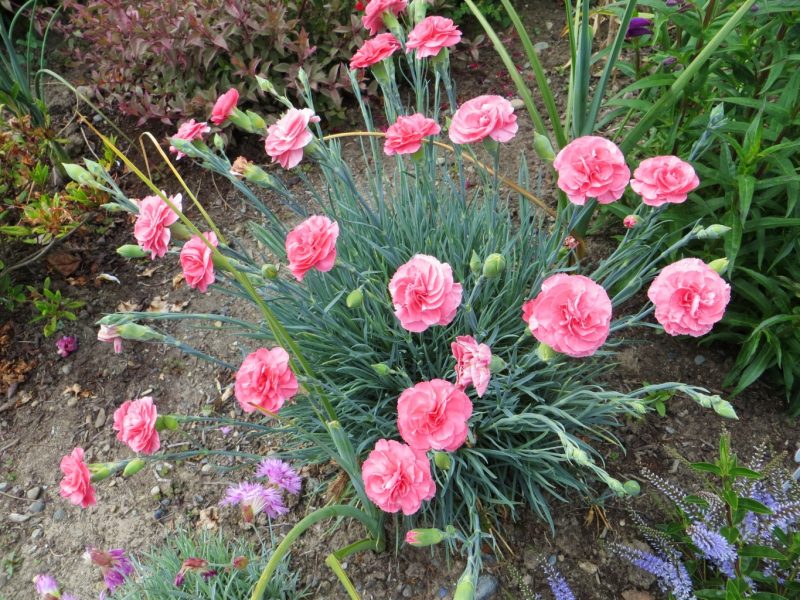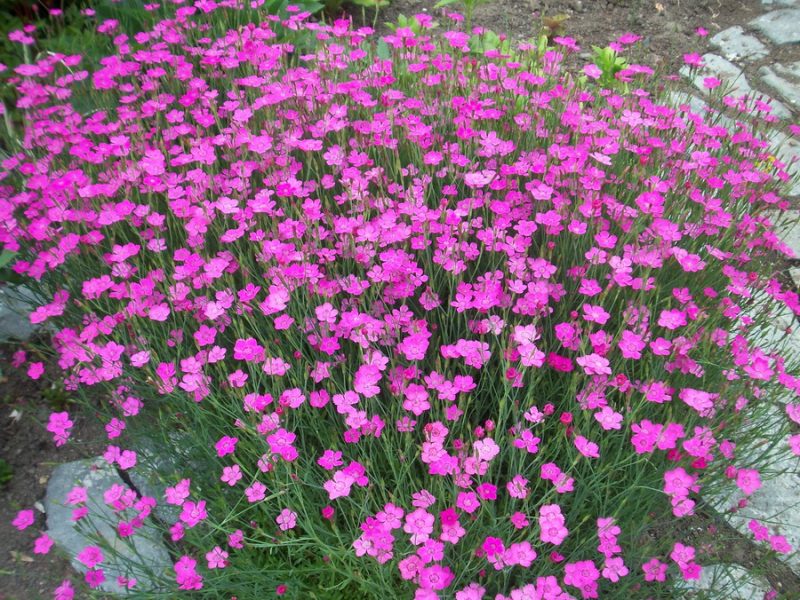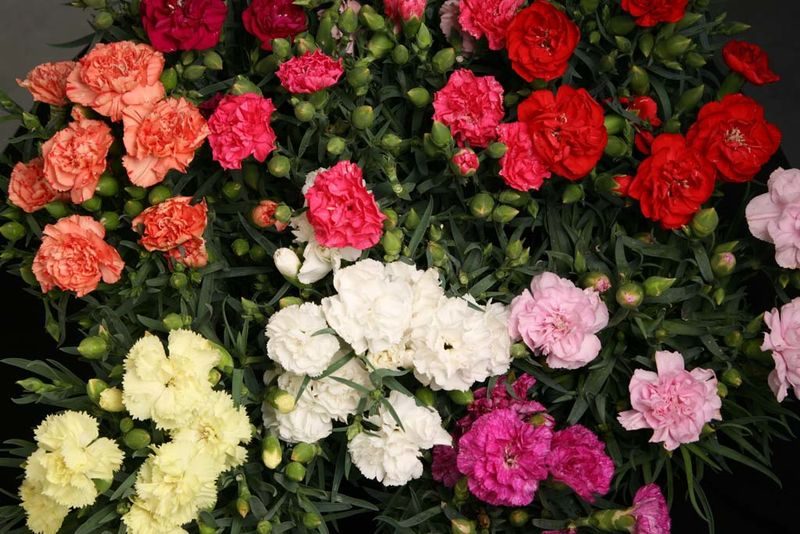An ornamental plant with bright flowers, a sweet aroma is a popular inhabitant of various types of flower beds. In addition, perennial garden cloves are suitable for container gardening of balconies, terraces, and patios. With the help of seedlings of modern varieties, you can quickly create beautiful floral carpets in pink, bright red, white and yellow.
Material Content:
Perennial cloves: cultivation features
To avoid confusion, you need to understand the botanical names. Garden clove (Dianthus caryophyllus) is a separate species with a rich history. However, in everyday life, often called "garden" different cloves, cultivated as ornamental plants.

The most famous species and subspecies:
- Garden or Dutch carnation is a perennial plant with a height of 20 to 70 cm.
- G. Turkish - grown as a biennial.
- G. lush - perennial plant.
- G. Alpine - perennial.
Attention! Almost all carnations introduced into the culture are perennials. However, in central Russia, thermophilic species are grown as biennials or annuals.
Simple linear leaves of cloves, depending on the variety, may be green or grayish-blue from a wax coating. The diameter and color of the corollas vary greatly. Flowers solitary or collected in several pieces bloom from June to August and September.
Subspecies Clove Shabo (Dianthus caryophyllus var. Schabaud) - a hybrid origin. Large-sized flowers, double or semi-double, of various colors: white, red, yellow, pink.Some varieties tolerate temperatures of –10 ° C for a short time. Winters in the open ground in central Russia in the presence of shelter.
Outdoor landing
The abundant flowering of carnations on flower beds and in containers depends on the correct choice of soil and place. This provides the plant with an uninterrupted supply of nutrients, water, and an optimal amount of light.
Soil requirements, site selection
Garden carnation prefers light, humus-rich, neutral and slightly alkaline soils. If the substrate is acidic, then add lime, ash. Heavy clay soils are improved by applying peat and sand. Peat and perlite are added to the soil for container culture.

For planting cloves, choose a well-lit area with light partial shade after 14 hours. Then the flowering will be quite long. A shady place is not suitable: leaf growth is inhibited, flowers most often do not develop. Plants in hanging flower pots, flowerpots and containers should be protected from direct sunlight, draining the soil.
Garden cloves are not recommended to be planted together with hygrophilous plants. Avoid locations near streams or other bodies of water where the soil is often swampy.
When and how to plant?
Perennial cloves are grown in seedlings. Sow seeds in late February or March, pre-soaking for a day. Prepare seedling boxes or other suitable containers with loose loamy soil.
Lay out the seeds on the surface of moist soil, sprinkle with a small amount of sand on top. The boxes are covered with glass or a transparent film, left in a dark place at a temperature of 17–20 ° С. After 4-7 days, seedlings appear. Tanks with seedlings are exposed on the windowsill, well lit by the sun. Spray with water from a spray bottle. After 3-4 weeks, young plants dive into the soil of the greenhouse. Then pickled seedlings are pinched to stimulate branching of the stem and root growth.

How is planting a clove on a permanent place:
- They dig holes at a distance of 15-30 cm and are deeper than the root ball.
- Compost and sand are added in a 3 cm layer to improve soil permeability.
- Dip seedlings in the hole, sprinkle with soil and condense around the roots.
- Watering the seedlings.
- Mulch the soil.
Attention! Drainage is necessary to divert excess water during irrigation. Clove does not tolerate waterlogging at any age. Young plants are particularly affected by waterlogging.
Direct sowing in the ground is carried out in mid-May. Seeds are deepened into the soil by 1 cm, covered with a film on top to accelerate germination and protect against cold. As soon as the shoots appear, the shelter is removed.
Perennial garden cloves: care
Seedlings are thinned out so that at least 30 cm is left between the plants. Planting is watered, weeds are destroyed. When the stems and leaves form a dense turf, weeding ceases.
Watering a plant

Perennial cloves better cope with a temporary lack of moisture than with its excess. Water the plants sparingly, only after drying the topsoil. A stream of water is directed to the soil around the root, and not to the leaves. Each time after watering, it is necessary to loosen the substrate so that a crust does not form.
Fertilizer and fertilizer
Well-rotted organics are added when planting and transplanting adult plants. Full mineral fertilizer is applied in the form of liquid top dressing in the spring before flowering and after pruning. Plants in containers are fed more often - every 4 weeks.
Care after flowering
If you pinch withered stems and inflorescences, then more new buds appear. Immediately after flowering, the stems are cut at a height of about 10 cm above the soil surface to maintain compactness.
Transfer

Strongly overgrown clove bushes are recommended to be transplanted to a new place. This procedure is best performed in August or September.
Clove propagation
Even a beginner grower can use any method of propagation of perennial cloves: sowing seeds into the soil, dividing the bush and cuttings. If the gardener wants to get a multi-colored carpet, then ready-made varietal mixtures are best suited.

A large mother bush in spring or after flowering is cut into pieces with a sharp knife or shovel. Each delenka needs a kidney. Parts are planted in a new place, watered. Valuable varieties are propagated by cuttings. Rooted shoots are rooted in containers filled with peat and sand. The substrate should be uniformly moist, but without stagnation of water. The roots grow back within 8 weeks.
Read also:planting and care for viburnum buldenezh
Plant diseases and pests
Cloves are little susceptible to disease, but high humidity, fluctuations in air temperature, and excess nitrogen contribute to the development of infection. If weeds are not removed, then they become sources of the spread of fungal spores, viral infections, and bacterial rot. Signs of fungal disease: the appearance on the leaves is first light, later brown spots with a red border. The plants are treated with fungicides Fundazole or Topaz.

Carnation pests - spider mites - cover the lower part of the leaves with a fine mesh. The thrips invasion is manifested by silver-white spots on the leaves and flower buds. Aphids suck juice from the most delicate parts of plants; they become pale green, often covered with mucus. From pests they are treated with biological insecticides: Fitoverm, Vertimek. You can spray with solutions of Aktara and Actellik preparations.
Types and varieties of perennial cloves
Florists are trying to choose decorative plants for the garden that retain freshness for a long time and do not require complicated maintenance. Dutch clove (Dianthus caryophyllus var. Semperflorens) ideally meets these conditions. This is a perennial, repairing plant (re-flowering). Hybrids that unite in a group are obtained by crossing several types and forms of cloves. The flowers are large, double, the petals have a fringe along the edge.

The dwarf clove garden "Lilipot" is becoming very popular among gardeners. This is a group of hybrids: “Yellow F1”, “Orange F1”, “Scarlet F1” with red petals, “White F1”, “Light Purple F1”. Plants with a height of up to 25 cm bloom profusely throughout the summer, remain compact without pinches, can be used for planting in open ground, containers and flowerpots.

Old varieties of cloves Shabo are grown mainly for cutting. Low-clove cloves from the F1 Dwarf mixture group of hybrids and the “Child of Nice” repair grade are suitable for flower decoration of rabatoks, mixborders, loggias and balconies, growing in containers. Compact bushes are plentifully covered with terry flowers. You can sow seeds in the soil or grow seedlings.
Even a beginner grower, a summer resident will be able to grow perennial garden cloves on a site or in a container. It is important to remember the needs and characteristics of the plant, follow the recommendations for growing seedlings and care. Carnation will thank for the care of abundant flowering and bright greens.












